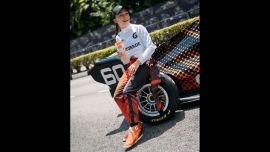Information on the 1970s in Argentina abounds, some of it baffling in the extent of violence and cruelty, sometimes reflecting immense concern as shown by the Grandmothers of Plaza de Mayo in their search for stolen children. And then again there are incidents that appear outrageous, on all sides. At times the action was by men and women who appeared to be quite ordinary in the context of human behaviour.
Perhaps these last were the worst, because they left behind an impression that sets them close to those well-spoken Nazi boys in films of the World War II. These people were able to commit the worst of horrors. Argentina was like that, in some ways. The trauma lingering is the will of some to black out the past. And that brings matters, or this writing, to the point. It is the reality of a society that cannot explain where the 1970s came from (apart from arriving after the 1960s). Well, it was that real society, its ‘best classes,’ that did it.
The concept of surrealism applies. But it is not the extreme absurdism of the surrealism of the early 1920s which wanted to unite the conscious and the unconscious as put forward in the Surrealist Manifesto of 1924. That introduces a new book by Marcelo Larraquy, a man who has worked for Clarín and has published some 10 books about Argentina’s politics. His first book was about Montonero activist Rodolfo Galimberti, who eventually died of a heart attack. Larraquy then went on to write the life story of the weird social welfare minister José López Rega, who tried to dominate the will of Juan Domingo Perón through magic mechanisms.
The new book is Bloody Spring (“Primavera Sangrienta”), published by Sudamericana, and it takes the reader through the three years between the abduction and murder of president Pedro Eugenio Aramburu to May 25, 1973, when dentist Héctor Cámpora became president for 39 days. His was the Amnesty law that threw open the prisons and freed all political prisoners. Aramburu was the de facto president after the overthrow of Juan Perón in 1955, up to the time Arturo Frondizi took office in 1958.
Aramburu was abducted by two young men, one a former Army cadet, on May 29, 1970 and murdered three days later. That was before the Montoneros group had been formed.
Larraquy’s Bloody Spring goes back to the men and women who formed two groups of activists, one in Buenos Aires, the other in Córdoba. Many of them had been educated at the elite school Colegio Nacional, some of the boys had gone to Army college, and a majority were staunch Roman Catholics. According to one of the founders of Montoneros, Ignacio Vélez Carreras, “there was a strong conviction that we had to produce incidents of great impact, that would give us prestige and would allow us to reorganise the Peronist masses.” These were young men speaking, averaging 23 years or so. You can re-read that statement and wonder what prestige was to them. When several of the suspects, secondary figures, went on trial in December 1970, Juan Perón sent a letter to one of those sentenced, with a sympathetic line of comfort. It might not be surreal. It must have been in part a product of Perón’s resentment at being overthrown, but the old man wanted to get back to Argentina and he was condoning murder.
Two murders had taken place already, but not by an organised group. The victims were Metal Workers’ Union chief Augusto Timoteo Vandor, who had won Perón’s rejection because he wanted to form a “Peronism without Perón” movement, and Garment Workers Union, José Alonso. Some activist groups were taking shape. The FAR (Revolutionary Armed Forces) was formed in July 1970, the Marxist, former Trotskyist, Workers’ Revolutionary Party (PRT) whence was born the ERP had taken shape in May, 1965. The original split off into numerous bits.
The flow of blood continued and grew. Many thought that the elections in 1973, eventually called by de facto head of state Alejandro Lanusse, would bring an end to the violence, or that the return of Juan Perón in June would stay the hand of the deadly guerrillas, and so on. But the ‘bloodgates’ had been opened and nobody was trying to close them.
For example, coinciding with the elections in 1973, a branch of the ERP led by former Communist militant Víctor Fernández Palmeiro decided that he would kill rear admiral Hérmes Quijada, an officer well-liked in the force. The plan was decided. Fernández Palmeiro, riding on pillion followed Quijada’s car from his home into town. The naval officer carried an automatic pistol.
At a traffic light, Fernández Palmeiro got off the bike, went to the car and fired point blank through the window. Quijada died in hospital. The driver got out and fired at the escaping motorcycle, hitting the guerrilla chief.
Fernández Palmeiro had been shot in a kidney. He was taken to a secret meeting-point, but refused to be taken to hospital and simply asked his comrades to buy him a bottle of whisky. He was lain down comfortably and he took sips of the drink all afternoon. His kidney drained. He bled to death. Regrettably, Larraquy, or the publishers, have not included an index, or name index.
The footnotes are OK, but there is no chapter listing. The 371 political prisoners are named. But that is not enough. Sudamericana should be ashamed of issuing an incomplete book like that.
(*) Former editor of the Buenos Aires Herald (1994-2007)




















Comments